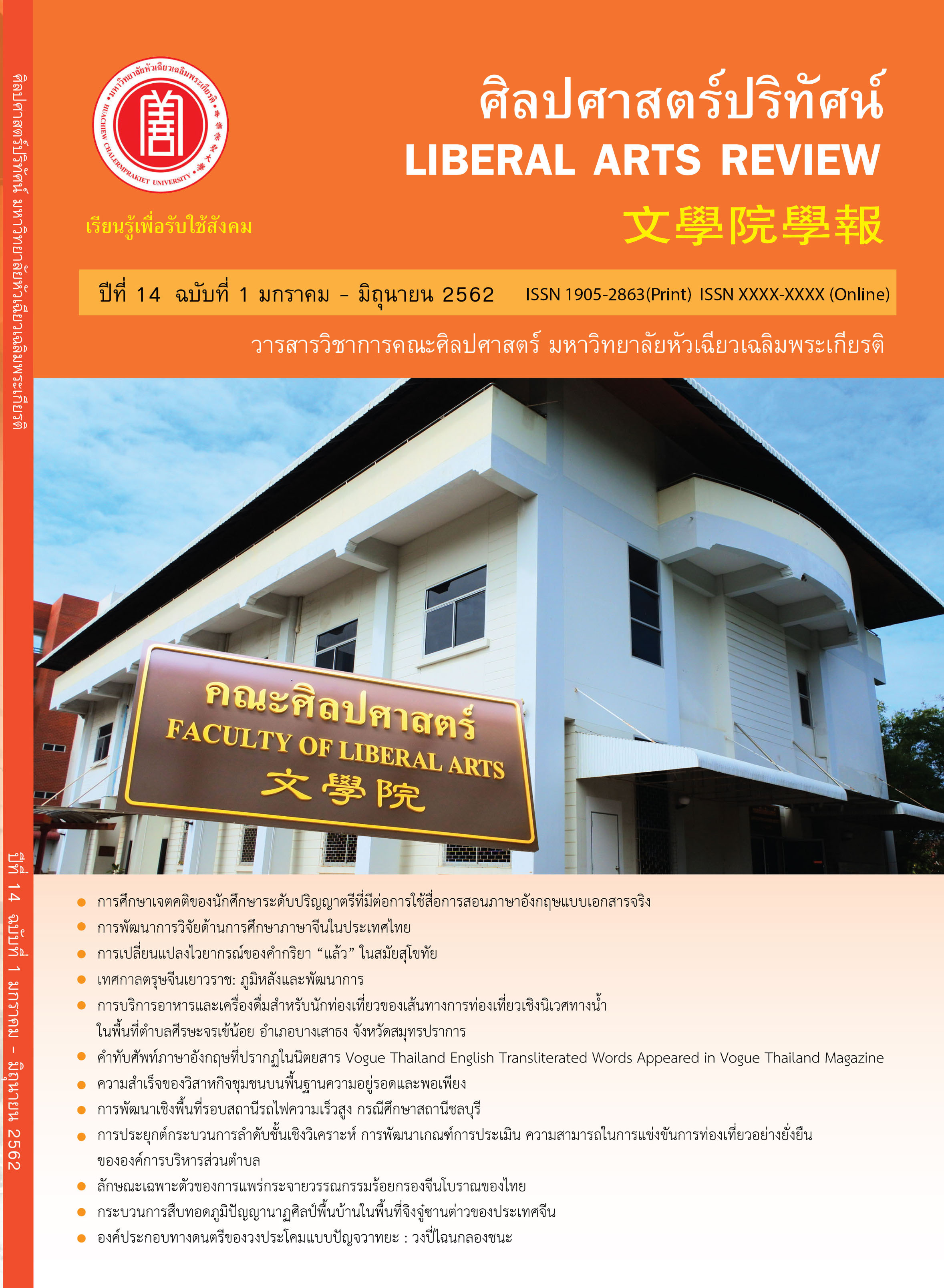Yaowarat Chinese New Year Festival:
Background and Development
Keywords:
Background and Development, Chinese New Year Festival YaowaratAbstract
The development of Yaowarat Chinese New Year Festival is in connection with the development of Thai society in many ways including political, economic, and sociocultural aspects. Each aspect is closely related to one another.
This research focuses on the Chinese community in Sampeng area during early Rattanakosin period when Bangkok city was established, continuing to the settlement of Chinese community in Yaowarat area which was founded in the reign of King Rama V as the most significant trading area of the country reflecting an eminent Chinese community in terms of people’s way of life, belief, arts, tradition, as well as physical features like household architectures and Chinese billboards along the street. Therefore, Yaowarat is generally accepted as Thailand’s China Town. According to an article mentioned about the Kingdom of Thailand in the reign of King Rama V, Chinese New Year at that time was seen as a lively celebration until the end of World War II in the period of Cold War when this festival became only an event among family members and relatives. Yaowarat Chinese New Year Festival; consequently, was celebrated quietly so as not to be outstanding and observed by authorities. However, later after 1987, the Thai government began its policy of promoting tourism and considered Yaowarat Chinese New Year Festival as stimulating the country’s economy. Also, Princess MahaChakriSirindhorn has been an important part in bringing Chinese New Year Festival in Yaowarat into an international recognition as a valuable and well-known annual event. Since 1987, Chinese New Year Festival in Yaowarat has been typically created to be a unique Chinese New Year celebration unlike any other countries in the world; for instance, a creative economic idea of annually designing clothes with Chinese zodiac year screens, community strengths, as well as occupational inheritance all of which have inspired a widespread educational trend of Chinese Studies. It can be said that Yaowarat Chinese New Year Festival is another example of a conservation conducted in parallel with a development.
References
กาญจนาคพันธุ์. (2545).กรุงเทพฯเมื่อวานนี้ (พิมพ์ครั้งที่ 4). กรุงเทพมหานคร: สารคดี. หนังสือชุด 100 ปี ขุนวิจิตรมาตรา.
ขนมเข่งใหญ่ที่สุดในโลก.(2536).สยามจดหมายเหตุ. 18(4), 87.
ธีรพันธ์ เหลืองทองคำ, และก่อศักดิ์ ธรรมเจริญกิจ. (2547).ศัพทานุกรม อาหารริมทางย่านเยาวราช. กรุงเทพมหานคร: โรงพิมพ์แห่งจุฬาลงกรณ์มหาวิทยาลัย.โครงการเผยแพร่ผลงานวิชาการคณะอักษร
ศาสตร์ จุฬาลงกรณ์มหาวิทยาลัย ลำดับที่ 91.
ประชุมคำให้การกรุงศรีอยุธยา รวม 3 เรื่อง:คำให้การชาวกรุงเก่า คำให้การขุนหลวงวัดประดู่ทรงธรรม คำให้การขุนหลวงหาวัด.(2553). กรุงเทพมหานคร: พงษ์วรินทร์การพิมพ์.
ปิยะนุช นาคคง.(12 กรกฎาคม 2558).สัมภาษณ์.
วิศิษฎ์ ลิ้มประนะ. ประธานและ CEO บริษัท อาจจิตต์ อินเตอร์เนชั่นแนลเพ็พเพอร์แอนด์สไปซ์ จำกัด. (28 กรกฎาคม 2557). สัมภาษณ์.
วิศิษฎ์ ลิ้มประนะ. ประธานและ CEO บริษัท อาจจิตต์ อินเตอร์เนชั่นแนลเพ็พเพอร์แอนด์สไปซ์ จำกัด. (27มกราคม 2558). สัมภาษณ์.
สถาบันไทย-จีนศึกษา. (2544). คติพจน์ปรัชญาขงจื่อ เล่ม 2 ความซื่อสัตย์และสันติภาพแห่งโลก. สมุทรปราการ: มหาวิทยาลัยหัวเฉียวเฉลิมพระเกียรติ.
สมชัย กวางทองพาณิชย์.(2556-2559). สัมภาษณ์.
สมชาย กรุสวนสมบัติ (ซูม). (4 มีนาคม 2557). สัมภาษณ์.
สุกัญญา สุจฉายา.(2555).เศรษฐกิจสร้างสรรค์กับการจัดการวัฒนธรรม. วารสารไทยศึกษา, 7(2), 217-293.
เสฐียรโกเศศ (พระยาอนุมานราชธน). (2547).ฟื้นความหลัง เล่ม 1(พิมพ์ครั้งที่ 4). กรุงเทพมหานคร: โรงพิมพ์ธรรมสาร.
แสงอรุณ กนกพงศ์ชัย.(2555).ประวัติชีวิตของคนไทยเชื้อสายจีนจากย่านสลัมคนจีนสู่การใช้กีฬาเพื่อพัฒนา-คุณภาพชีวิตและสังคม. วารสารศิลปศาสตร์ปริทัศน์,7(14),72-82.
หลิน ปัน. (2540).อึ่งตี่เกี้ย: เรื่องราวของชาวจีนโพ้นทะเลทั่วโลก. เกษียร เตชะพีระ ผู้แปล.กรุงเทพมหานคร: คบไฟ.
เฮง เหง่ง ฮุ้ง. (16 กรกฎาคม 2557). สัมภาษณ์.
Downloads
Published
How to Cite
Issue
Section
License
บทความที่ได้รับการตีพิมพ์เป็นลิขสิทธิ์ของวารสารศิลปศาสตร์วิชาการและวิจัย
ข้อความที่ปรากฏในบทความแต่ละเรื่องในวารสารวิชาการเล่มนี้เป็นความคิดเห็นส่วนตัวของผู้เขียนแต่ละท่านไม่เกี่ยวข้องกับมหาวิทยาลัยหัวเฉียวเฉลิมพระเกียรติ และคณาจารย์ท่านอื่นๆ ในมหาวิทยาลัยฯ แต่อย่างใด ความรับผิดชอบองค์ประกอบทั้งหมดของบทความแต่ละเรื่องเป็นของผู้เขียนแต่ละท่าน หากมีความผิดพลาดใดๆ ผู้เขียนแต่ละท่านจะรับผิดชอบบทความของตนเองแต่ผู้เดียว




